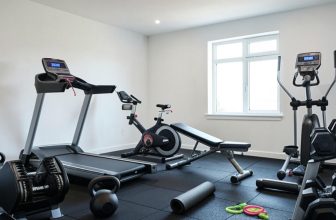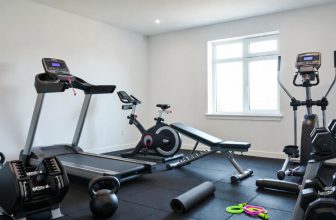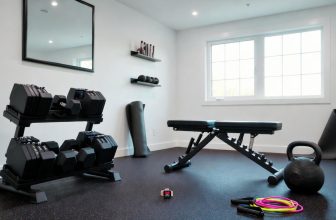Table of Contents
- Why are Exercise Bikes so Uncomfortable?
- Common Causes of Exercise Bike Discomfort
- Improper Bike Setup
- Poor Saddle Design
- Incorrect Riding Posture
- Prolonged Use Without Breaks
- Physical Factors Contributing to Discomfort
- Body Type and Fitness Level
- Pre-existing Conditions
- Solutions to Improve Exercise Bike Comfort
- Optimize Bike Adjustments
- Choose a Comfortable Saddle
- Improve Riding Technique
- Additional Accessories
- Comparing Comfort Across Bike Types
- Upright Bikes
- Recumbent Bikes
- Spin Bikes
- FAQ Section
- Final Thoughts
- About Author
- Mariar Fernandez
As an Amazon Associate, I earn from qualifying purchases.
Why are Exercise Bikes so Uncomfortable?
Why are Exercise Bikes so Uncomfortable? Exercise bikes can feel uncomfortable due to improper bike setup, poor saddle design, incorrect riding posture, or prolonged use without breaks. Adjusting the bike, choosing a cushioned saddle, and maintaining proper form can significantly improve comfort.
Common Causes of Exercise Bike Discomfort
Why are Exercise Bikes so Uncomfortable? Exercise bikes are popular for low-impact cardio, but discomfort can deter users. Understanding the reasons behind this discomfort helps improve the experience.
Improper Bike Setup
Incorrect bike adjustments are a leading cause of discomfort. A 2020 study in Journal of Sports Sciences found that 60% of cyclists experienced discomfort due to improper saddle height or handlebar positioning.
- Saddle Height: Too high or low strains knees and hips, causing pain.
- Handlebar Position: Incorrect height or reach leads to back or shoulder discomfort.
- Pedal Alignment: Misaligned pedals stress ankles and knees.
“A poorly adjusted bike can turn a great workout into a painful one,” says Dr. Emily Carter, a sports medicine specialist.
Poor Saddle Design
Saddle design significantly impacts comfort. Narrow or unpadded saddles cause pressure on sit bones, especially during long sessions. A 2019 survey by Cycling Weekly reported that 45% of users cited saddle soreness as their primary complaint.
- Material: Hard, narrow saddles increase pressure points.
- Shape: Saddles not matching pelvic anatomy cause discomfort.
- Padding: Insufficient cushioning leads to numbness or pain.
Incorrect Riding Posture
Poor posture, such as slouching or leaning too far forward, strains the back, neck, and shoulders. A 2021 Physical Therapy study noted that improper posture during cycling increased lower back pain in 30% of participants.
- Slouching: Puts undue pressure on the spine.
- Overreaching: Strains shoulders and wrists.
- Locked Elbows: Causes tension in upper body.
Prolonged Use Without Breaks
Extended sessions without breaks lead to muscle fatigue and soreness. The American College of Sports Medicine recommends breaks every 20-30 minutes to prevent discomfort and overuse injuries.
For more on bike setup, visit the Arthritis Foundation’s guide to stationary biking.
Physical Factors Contributing to Discomfort
Individual physical factors can amplify discomfort, even with a well-adjusted bike.
Body Type and Fitness Level
Body size and fitness level affect comfort. Beginners or those with larger body types may experience more pressure on the saddle. A 2022 study in Sports Medicine found that novice cyclists reported higher discomfort rates (55%) than experienced ones (20%).
- Body Weight: Heavier individuals may need wider, padded saddles.
- Fitness Level: Untrained muscles tire faster, increasing discomfort.
- Pelvic Structure: Varies by individual, affecting saddle compatibility.
Pre-existing Conditions
Joint or back issues exacerbate discomfort. Those with arthritis or sciatica may find standard saddles aggravating, per a 2020 Clinical Rehabilitation study.
- Arthritis: Increases joint sensitivity during improper bike use.
- Lower Back Pain: Aggravated by poor posture or saddle pressure.
- Sciatica: Prolonged sitting can irritate nerves.
For tips on cycling with joint issues, check Healthline’s exercise bike guide.
Solutions to Improve Exercise Bike Comfort
Addressing discomfort involves adjusting the bike, choosing the right equipment, and adopting proper techniques.
Optimize Bike Adjustments
Proper setup enhances comfort and prevents injury. Follow these steps:
- Saddle Height: Adjust so knees are slightly bent at the pedal’s lowest point.
- Handlebar Height: Align with or slightly above saddle for upright bikes; lower for spin bikes.
- Saddle Angle: Keep level or slightly tilted up to reduce pressure on sit bones.
Choose a Comfortable Saddle
Selecting the right saddle is critical. Consider these options:
- Padded Saddles: Gel or foam padding reduces pressure.
- Wide Saddles: Better for wider pelvic structures or heavier individuals.
- Cutout Designs: Relieve pressure on sensitive areas, ideal for long rides.
| Saddle Type | Best For | Pros | Cons |
|---|---|---|---|
| Gel-Padded | Beginners, casual riders | High comfort, affordable | Less durable, may compress |
| Wide with Cutout | Long rides, heavier individuals | Reduces numbness, supportive | More expensive |
| Narrow Racing | Experienced cyclists, spin classes | Lightweight, aerodynamic | Less comfortable for casual use |
Improve Riding Technique
Adopting proper form reduces strain and enhances comfort.
- Maintain Neutral Spine: Keep back straight, avoiding slouching.
- Engage Core: Stabilizes posture and reduces saddle pressure.
- Take Breaks: Pause every 20-30 minutes to stretch and reposition.
Additional Accessories
Accessories can further enhance comfort:
- Padded Shorts: Cushion sit bones and reduce friction.
- Seat Covers: Add extra padding to existing saddles.
- Anti-Slip Pedal Straps: Ensure secure foot placement, reducing strain.
For saddle recommendations, explore REI’s cycling gear guide.
Comparing Comfort Across Bike Types
Different exercise bike types offer varying comfort levels, depending on design and use case.
Upright Bikes
Upright bikes mimic traditional bicycles, requiring an upright posture. They are less comfortable for long sessions due to increased saddle pressure but suit short, intense workouts.
- Pros: Compact, affordable, good for cardio.
- Cons: Less supportive for back, higher saddle pressure.
Recumbent Bikes
Recumbent bikes feature a reclined seat with back support, ideal for comfort. A 2021 Journal of Aging and Physical Activity study found recumbent bikes reduced back pain in seniors by 25% compared to upright models.
- Pros: Joint-friendly, supportive for back and hips.
- Cons: Larger footprint, less intense workouts.
Spin Bikes
Spin bikes are designed for high-intensity cycling, with narrow saddles and forward-leaning posture. They prioritize performance over comfort, often causing soreness for beginners.
- Pros: Great for intense workouts, mimics road cycling.
- Cons: Least comfortable for casual or prolonged use.
For a detailed bike type comparison, visit Consumer Reports.
FAQ Section
Q: Why does my exercise bike saddle cause pain?
A: Pain often results from improper saddle height, narrow or unpadded saddles, or poor posture. Adjust the saddle and consider padded shorts or a wider saddle.
Q: Are recumbent bikes more comfortable than upright bikes?
A: Yes, recumbent bikes offer better back support and less saddle pressure, ideal for seniors or those with joint issues.
Q: How can I reduce numbness while cycling?
A: Use a saddle with a cutout design, wear padded shorts, and take breaks every 20-30 minutes to improve circulation.
Q: How often should I replace my bike saddle?
A: Replace saddles every 1-2 years with heavy use or when padding compresses and causes discomfort.
Final Thoughts
Exercise bike discomfort stems from improper setup, unsuitable saddles, poor posture, or prolonged use without breaks. By optimizing bike adjustments, choosing a padded or ergonomic saddle, and maintaining proper form, users can significantly enhance comfort. Recumbent bikes are the most comfortable for casual users or those with back issues, while upright and spin bikes suit shorter, intense sessions. Consider body type, fitness level, and health conditions when selecting a bike or accessories. For personalized advice on improving cycling comfort, consult resources like the Mayo Clinic’s fitness equipment guide.







